Unnamed Cave 61
Throughout a caver's career, certain caves stand out as important, or defining to them. Unnamed Cave 61 is the cave that stands out for me (the cave does have a name, but in the convention of archaeological sites, we do not share its name). I was present when the discovery of its prehistoric art was first made. I initially brought cavers there on a lead by a neighbor. We believed that we were the first to have documented the cave, but later learned that it had been previously described, but the location was wrong. I corrected the error and merged the records within the Tennessee Cave Survey dataset.
This cave I have come to think of as "mine" though I in no way own or have any particular claim to it. All that serves to preface my walkthrough of the cave, and its amazing contents.
Chris Morris made this lovely 3d model of the panel that can be viewed here
This first panel has some spectacular interpretation, which I will attempt to provide you with. The main panel has a geologic feature called a styolite (8) that runs across it. The artists appear to have used this naturally occurring geologic feature to separate the underworld with the land above within the context of their art. Knowing this about the styolite one can clearly discern the three realms of Native American mythology: The heavens, Earth, and the underworld.
In the heavens, one can see a star shape (1), likely representing the sun. In the underworld one can see a cresent moon (2), and a pack of quadrupeds (4). The right-most quadruped is turned vertical approximately 90 degrees (6). Around the corner, is the warrior (3) with a headress on and bow drawn.
The Earth portion of the panel includes a figure, dubbed "Touchdown man" (5) who has his arms thrown to the heavens. Another quadruped (7) is visible and deep scratches (10) which mar a portion of the pictograph. The scratches are believed to have been from a later Native American that visited the cave. Perhaps they disagreed with the symbology, or wanted to have their own conversation with the cave.
Returning to the warrior, his placement is important within the cave. He is hiding around the corner from the entrance of the cave, weapon ready. He is guarding the cave with his pack of quadrupeds - or perhaps they are dogs. The last dog, the one turned vertically is drawn that way because it is metaphorically on the steep slope at the entrance of the cave. This spirit warrior, drawn by a Native American is believed to be the cave's protector.
This cave I have come to think of as "mine" though I in no way own or have any particular claim to it. All that serves to preface my walkthrough of the cave, and its amazing contents.
Chris Morris made this lovely 3d model of the panel that can be viewed here
This first panel has some spectacular interpretation, which I will attempt to provide you with. The main panel has a geologic feature called a styolite (8) that runs across it. The artists appear to have used this naturally occurring geologic feature to separate the underworld with the land above within the context of their art. Knowing this about the styolite one can clearly discern the three realms of Native American mythology: The heavens, Earth, and the underworld.
In the heavens, one can see a star shape (1), likely representing the sun. In the underworld one can see a cresent moon (2), and a pack of quadrupeds (4). The right-most quadruped is turned vertical approximately 90 degrees (6). Around the corner, is the warrior (3) with a headress on and bow drawn.
The Earth portion of the panel includes a figure, dubbed "Touchdown man" (5) who has his arms thrown to the heavens. Another quadruped (7) is visible and deep scratches (10) which mar a portion of the pictograph. The scratches are believed to have been from a later Native American that visited the cave. Perhaps they disagreed with the symbology, or wanted to have their own conversation with the cave.
Returning to the warrior, his placement is important within the cave. He is hiding around the corner from the entrance of the cave, weapon ready. He is guarding the cave with his pack of quadrupeds - or perhaps they are dogs. The last dog, the one turned vertically is drawn that way because it is metaphorically on the steep slope at the entrance of the cave. This spirit warrior, drawn by a Native American is believed to be the cave's protector.
 1 - Star |
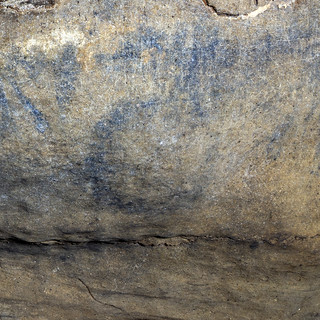 2 - Moon |
 3 - Warrior |
 4 - Quadrupeds |
 5 - Touchdown Man |
 6 - Vertical quadruped |
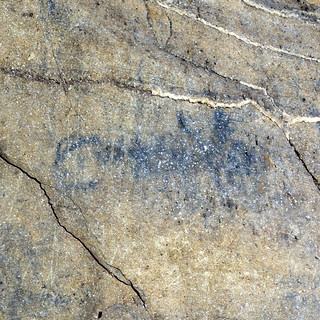 7 - Above ground quadruped |
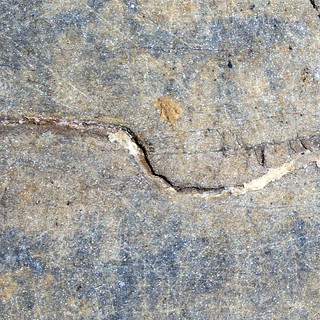 8 - Styoloite |
| 9 - Stokemarks (not pictured) |
 10 - Petroglyphs atop pictographs |
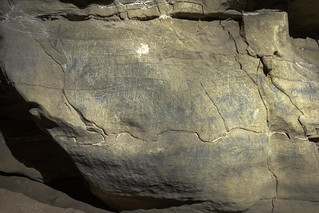


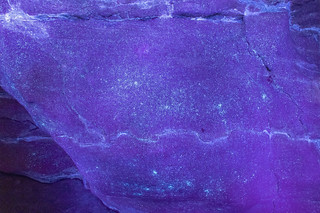
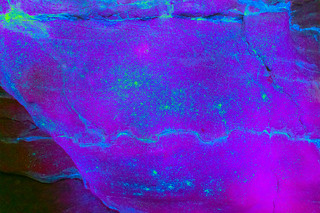
Comments